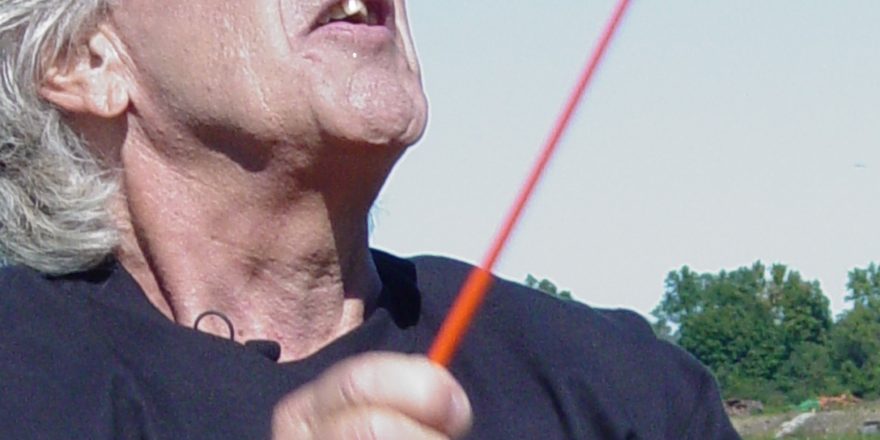Wave a Wand and Get Fit
Conductorcise is a one-hour aerobics-style class that blends conducting with music appreciation.
The conference room was packed with fitness professionals looking for the latest thing to bring home to their health clubs and senior centers. But instead of yoga mats and dumbbells lining the floor, everyone was outfitted with just one thing: a conductor’s baton. When the music cranked up, it wasn’t techno or hip-hop, but Sousa and Strauss. And leading it all was David Dworkin, a 75-year-old New York-based conductor and clarinetist who retired from a life of international performance and came up with Conductorcise — a one-hour aerobics-style class that blends conducting with music appreciation.
“It’s an upper body workout, but the blood flow goes all over,” says the enthusiastic Dworkin, who clearly loves what he does. “This isn’t a program where you’re sculpting your body in the gym. It’s a program for the mind because it activates the brain, and it’s a program for the body because you’re moving and creating.”
In keeping with his personality, it’s done in a light and humorous way. Participants are handed a baton, then Dworkin goes through a few basic conducting patterns. As symphony passages unfold, Dworkin talks about the music’s history and asks the class to notice a piccolo playing or the conversation between woodwinds and strings. “It’s like art,” says Dworkin, a Juilliard graduate who majored in clarinet, then earned a music education degree at Columbia University. “I point things out, like you’d notice in a painting.”
A Proven Benefit
Always a fitness enthusiast, Dworkin traveled the world for four decades, conducting and playing clarinet. “I’d be sweating, and my pulse rate would be up, and I’d be high as a kite because I’d be releasing endorphins,” he says. When he wound down his career a few years ago, “I decided I’d love to create a program that combined the physical feelings with the intellectual stimulation you get when you’re conducting.”
It’s no secret that music enhances exercise and stimulates the brain. Long-term research by psychologist Dr. Costas Karageorghis, for example, found that music can increase endurance by 15 percent and can help exercisers feel more positive about working out, even at very high intensities. At the gym or outside, exercisers tend to keep going until a song is over, rather than quit before it ends.
Surprise Ovations
In 2008, the International Council on Active Aging recognized Conductorcise with an Innovators Award, which “recognizes creativity and excellence in active-aging programs and products.” “When you see David and his humor and the music and the smiles on people’s faces,you say ‘Wow — you can do all that with a simple little stick,'” says the council’s CEO, Colin Milner. “He’s like the Energizer Bunny, bouncing around while he does this, getting people totally involved. And the nice part is it’s accessible for anyone, whether you’re in a wheelchair, (use) a walker, or you’re a marathon runner.”
Dr. John Ratey, a clinical associate professor of psychiatry at Harvard and the author of “Spark: The Revolutionary New Science of Exercise and the Brain,” has worked with Dworkin and watched him teach. “The music, the fun, the engagement, the rhythm is so uplifting for the human spirit,” says Ratey. When Dworkin taught a Conductorcise class at a Boston-area nursing home, “some of the people in wheelchairs stood up, longer than I’d ever seen,” said Susan Pelican, director of the Ratey Institute. “People using walkers even got up and startedwalking in time to the music.”
The biggest strength of the program, Milner says, is that it gets non-exercisers exercising. “That’s a challenge we have with the 65-plus population; there’s been virtually zero increase in their level of physical activity in the past decade. “We keep trying to sell them on busting their butt on a treadmill, but they’re not interested. This is getting a lot of nonavid exercisers involved.”
The classes have been extremely effective for people suffering from Alzheimer’s and Parkinson’s disease. Music therapist Kathleen Brown became a Conductorcise instructor after she invited Dworkin to work with Parkinson’s patients at Scott & White Hospital in Temple, Texas.
“He kept this group of patients and their families going for a solid hour, and they loved it,” Brown says. “It raised their spirits, and everyonewas smiling. People with Parkinson’s don’t show a lot because of their ‘masked’ face, but even with that you could see they were happy.”
Built-In Flexibility
Conductorcise, explains Brown, can be adjusted to the needs of a group. “This (Parkinson’s) group was seated, but it can be done standing or marching around.” Marching’s especially fun for kids, and Dworkin has done Conductorcise using music by Sousa, Strauss and Bizet.
“I’ll play Ippolitov-Ivanov’s ‘Caucasian Sketches’ and tell the kids where the Caucasus Mountains are, and talk about their costumes and marches. I’ll play the Radetzky March and talk about how horses dance.”
“We see so many programs, and it’s all the same stuff,” Milner says. “It’s really inspiring when someone comes up with a new idea that actually grabs people’s attention and gets them involved.”


